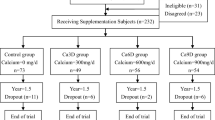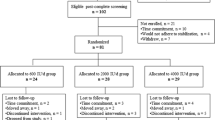Abstract
One hundred and twelve Caucasian girls, 11.9±0.5 years of age at entry, were randomized into a 24-month, double-masked, placebo-controlled trial to determine the effect of calcium supplementation on bone mineral content, bone area and bone density. Supplementation was 500 mg calcium as calcium citrate malate (CCM) per day. Controls received placebo pills, and compliance of both groups averaged 72%. Bone mineral content, bone mineral area and bone mineral density of the lumbar spine and total body were measured by dual energy X-ray absorptiometry (DXA). Calcium intake from dietary sources averaged 983 mg/day for the entire study group. The supplemented group received, on average, an additional 360 mg calcium/day from CCM. At baseline and after 24 months, the two groups did not differ with respect to anthropometric measurements, urinary reproductive hormone levels or any measurement of pubertal progression. The supplemented group had greater increases of total body bone measures: content 39.9% versus 35.7% (p=0.01), area 24.2% versus 22.5% (p=0.15) and density 12.2% versus 10.1% (p=0.005). Region-of-interest analyses showed that the supplemented group had greater gains compared with the control group for bone mineral density, content and area. In particular, in the lumbar spine and pelvis, the gains made by the supplemented group were 12%–24% greater than the increases made by the control group. Bone acquisition rates in the two study groups were further compared by subdividing the groups into those with below- or above-median values for Tanner score and dietary calcium intake. In subjects with below-median Tanner scores, bone acquisition was not affected by calcium supplementation or dietary calicum level. However, the calcium supplemented subjects with above-median Tanner had higher bone acqusition rates than the placebo group with above-median Tanner scores. Relative to the placebo group, the supplemented group had increased yearly gains of bone content, area and density which represented about 1.5% of adult female values. Such increases, if held to adult skeletal maturity, could provide protection against future risk of osteoporotic fractures.
Similar content being viewed by others
References
Heaney RP. The natural history of vertebral osteoporosis. Is low bone mass an epiphenomenom? Bone 1992;13:S23–6.
Johnston CC, Slemenda CW. Determinants of peak bone mass. Osteoporosis Int 1992;Suppl 1:S54–5.
Kanis JA, McCloskey EV. Epidemiology of vertebral osteoporosis. Bone 1992;13:S1–10.
Dempster DW, Lindsay R. Pathogenesis of osteoporosis. Lancet 1993;341:797–805.
Katzman DK, Bachrach LK, Carter DR, Marcus R. Clinical and anthropometric correlates of bone mineral acquisition in healthy adolescent girls. J Clin Endocrinol Metab 1991;73:1332–9.
Bonjour JP, Theintz G, Buchs B, Slosman D, Rizzoli R. Critical years and stages of puberty for spinal and femoral bone mass accumulation during adolescence. J Clin Endocrinol Metab 1991;73:555–63.
Glastre C, Braillon P, David L, Cochat P, Meunier PJ, Delmas PD. Measurement of bone mineral content of the lumbar spine by dual energy x-ray absorptiometry in normal children: correlations with growth parameters. J Clin Endocrinol Metab 1990;70:1330–3.
Gilsanz V, Roe TF, Mora S, Costin G, Goodman WG. Changes in vertebral bone density in black girls and white girls during childhood and puberty. N Engl J Med 1991;325:1597–600.
Fleming KH, Heimbach JT. Consumption of calcium in the United States: food sources and intake levels. J Nutr 1994;124:S1426–30.
Lloyd T, Andon MA, Rollings N, et al. Calcium supplementation and bone mineral density in adolescent girls. JAMA 1993;270:841–4.
Lloyd T, Rollings N, Andon MB, et al. Determinants of bone density in young women. I. Relationships among pubertal development, total body bone mass, and total body bone density in premenarchal females. J Clin Endocrinol Metab 1992;75:383–7.
Demers LM, Lipton A, Harvey HA, et al. The efficacy of CGS 20267 in suppressing estrogen biosynthesis in patients with advanced stage breast cancer. J Steroid Biochem Mol Biol 1993;44:687–91.
Lloyd T, Eggli DF. Measurement of bone mineral content and bone density in healthy twelve-year-old white females. J Nucl Med 1992;33:1143–5.
Johnson CC, Slemenda CW, Melton LJ. Clinical use of bone densitometry. N Engl J Med 1991;324:1105–9.
Smith KT, Heaney RP, Flora L, Hinders SM. Calcium absorption from a new calcium delivery system (CCM). Calcif Tissue Int 1987;41:351–2.
Miller JZ, Smith DL, Flora L, Slemenda C, Jiang XY, Johnston CC. Calcium absorption from calcium carbonate and a new form of calcium (CCM) in healthy male and female adolescents. Am J Clin Nutr 1988;48:1291–4.
Nutritionist III (Version 7.0) Salem, OR; N-squared computing analytical software.
SAS Institute. SAS/STAT user guide, release 6.03. Cary, NC: SAS Institute, 1988.
Vonesh EF, Carter RL. Mixed effects nonlinear regression for unbalanced repeated measures. Biometrics 1992;48:1–17.
Marshall WA, Tanner JM. Variations in patterns in pubertal changes in girls. Arch Dis Child 1969;44:291–303.
Hamill PW, Drizd TA, Johnson CL. Physical growth: national center for health statistics percentiles. Am J Clin Nutr 1979;32:706–629.
Wright HS, Guthrie HA, Wang MQ, Bernardo V. The 1987–86 nationwide food consumption survey: an update on the nutrient intake of respondents. Nutr Today 1991;26:21–7.
Johnston CC Jr, Miller JZ, Slemenda C, et al. Calcium supplementation and increases in bone mineral density in children. N Engl J Med 1992;327:82–7.
Theintz G, Buchs B, Rizzoli R, et al. Longitudinal monitoring of bone mass accumulation in healthy adolescents: evidence of a marked reduction after 16 years of age at the levels of lumbar spine and femoral neck in female subjects. J Clin Endocrinol Metab 1992;75:1060–5.
Recker RR, Davies M, Hinders SM, Heaney RP, Stegman MR, Kimmel D. Bone gain in young adult women. JAMA 1992;268:2403–8.
Einhorn T. Bone strength: the bottom line [editorial]. Calcif Tissue Int 1992;51:333–9.
Gilsanz V, Boechat MI, Roe TF, Loro ML, Sayre JW, Goodman WG. Gender differences in vertebral body sizes in children and adolescents. Radiology 1994;190:673–7.
Faulkner KG, McClung M, Cummings SR. Automated evaluation of hip axis length for predicting hip fracture. J Bone Miner Res 1994;9:1065–70.
Nakamura T, Turner CH, Yoshikawa T, et al. Do variations in hip goemetry explain differences in hip fracture risk between Japanese and white Americans? J Bone Miner Res 1994;9:1071–6.
Bouxsein ML, myburgh KH, van der Meulen MCH, Lindenberger E, Marcus T. Age-related differences in cross-sectional geometry of the forearm bones in healthy women. Calcif Tissue Int 1994;54:113–8.
Martin B. Aging and strength of bone as a structural material. Calcif Tissue Int 1993:53:534–40.
Heaney RP. The bone-remodeling transient: implications for the interpretation of clinical studies of bone mass change. J Bone Miner Res 1994;9:1515–23.
Slemenda C, Reister TK, Peacock M, Johnston CC. Bone strength in children following the cessation of calcium supplementation. J Bone Miner Res 1993;8:S154.
Rosenthal DI, Mayo-Smith W, Hayes CW, et al. Age and bone mass in premenopausal women. J Bone Miner Res 1989;4:533–8.
Matkovic V, Kostial K, Simononic I, Bugina R, Brodarec A, Nordin BEC. Bone status and fracture rates in two regions of Yugoslavia. Am J Clin Nutre 1979;32:540–9.
Author information
Authors and Affiliations
Rights and permissions
About this article
Cite this article
Lloyd, T., Martel, J.K., Rollings, N. et al. The effect of calcium supplementation and tanner stage on bone density, content and area in teenage women. Osteoporosis Int 6, 276–283 (1996). https://doi.org/10.1007/BF01623385
Received:
Accepted:
Issue Date:
DOI: https://doi.org/10.1007/BF01623385




